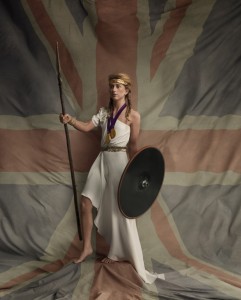Our Courses
Finding the strategy for creating a great picture
Chris Floyd’s photograph of Laura Trott is sure to become an iconic image of the success of this year’s Olympic Games and also of this extraordinary young woman. It is subtle, strong and filled with symbolism, look closely- her shield is a wheel from her bike! Even more compelling than the photo itself, though, is the fascinating story behind how the photographer brought this image into being.
 As an NLP practitioner I am always aware of the way in which NLP is at work in all of us, whether we are consciously practising it or not. When I read Chris Floyd’s article on his photo shoot with Olympian Laura Trott, the wealth of tools he was unknowingly describing leapt off the page at me.
As an NLP practitioner I am always aware of the way in which NLP is at work in all of us, whether we are consciously practising it or not. When I read Chris Floyd’s article on his photo shoot with Olympian Laura Trott, the wealth of tools he was unknowingly describing leapt off the page at me.
Floyd clearly describes his strategy for planning the look of a photograph, telling us how he flicks through a mental ‘rolodex’ of artists he admires until he finds the one that ‘instinctively feels like the inspirational match for the task at hand’. I’d love to push him further at this point – how does he know? Is it a feeling in his body? Does one image become bigger than the others? Is there a phrase or voice inside his head that tells him it’s ‘the one’?
His use of metaphorical language is also fascinating, as he describes the ‘jumping off’ point, artists that ‘keep him company’ on his creative journey, ‘getting to the other side’ of the project and producing something that ‘tastes new and different’. Here then is a man who begins with a visual submodality then shifts into a kinaesthetic submodality as he proceeds with his work, and he is telling us this all through the words he chooses to use.
He models the artist he chooses, Irving Penn, aiming to work in a similar way to the iconic photographer and holds a central theme of ‘spirit’ as his guiding principle of what it is he wants to capture in his photograph. And all along the way he is working on what ‘feels’ right.
Just by paying close attention to this famous photographer’s description of his process, we can harness the strategy for ourselves. I know the next time I want to take a great picture, for example of my trip to Kerala, India in December with Sue Knight, I’m going to draw on Chris Floyd’s process. I’ll start by flicking through my own mental image bank for an image I’ve seen that ‘feels’ right. I’m going to have a word that sums up what I want to convey in mind, I’m going to be aware of the kinaesthetic data I’m receiving and I’ll be able to come home with some great photographs.
I look forward to sharing them with you!
Sue
Chris Floyd’s full article and links to his other beautiful images can be found here
http://chrisfloyduk.wordpress.com/2012/08/19/rule-britannia/
Latest News/Blog
Mind your language…
Demotion, emotion, locomotion:The importance of rapport and language. MP’s have quite a tough job. No, don’t worry, I’m not about to start waxing lyrical about what they do for us and how hard it is installing a duck house on …
Bringing Optimism to the Workplace
If you think that looking for the problems and challenging everything presents you in a smarter, more discriminating light, you might want to re-think that. Unless, of course, with every problem you find, you already have a solution.
I believe it’s all in the mind
So having watched the channel 4 program about people who remember everything, what do we think about how and why they do it? When they were asked this question they made the very common response, ‘I don’t know, I just do’.
